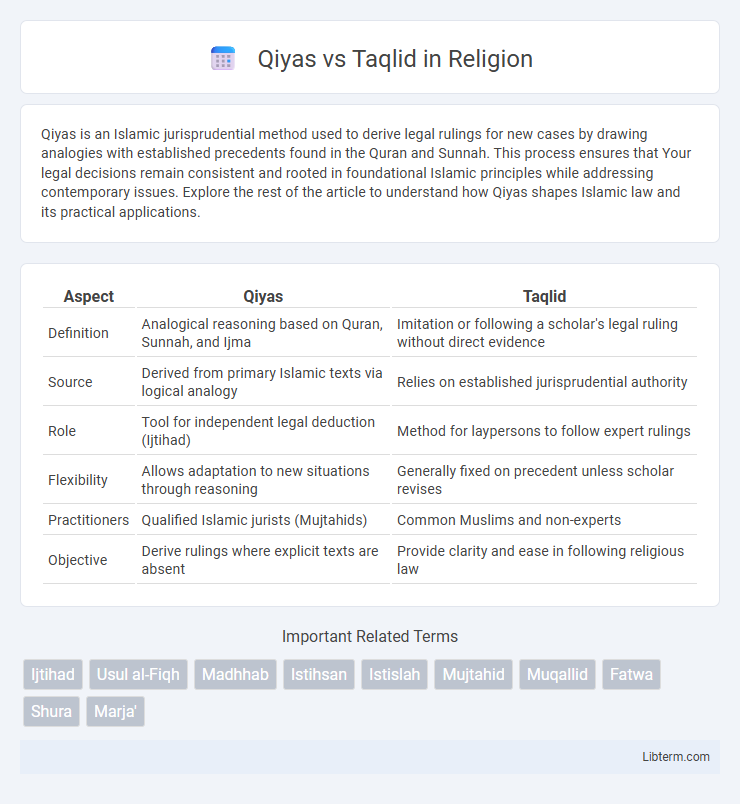Qiyas is an Islamic jurisprudential method used to derive legal rulings for new cases by drawing analogies with established precedents found in the Quran and Sunnah. This process ensures that Your legal decisions remain consistent and rooted in foundational Islamic principles while addressing contemporary issues. Explore the rest of the article to understand how Qiyas shapes Islamic law and its practical applications.
Table of Comparison
| Aspect | Qiyas | Taqlid |
|---|---|---|
| Definition | Analogical reasoning based on Quran, Sunnah, and Ijma | Imitation or following a scholar's legal ruling without direct evidence |
| Source | Derived from primary Islamic texts via logical analogy | Relies on established jurisprudential authority |
| Role | Tool for independent legal deduction (Ijtihad) | Method for laypersons to follow expert rulings |
| Flexibility | Allows adaptation to new situations through reasoning | Generally fixed on precedent unless scholar revises |
| Practitioners | Qualified Islamic jurists (Mujtahids) | Common Muslims and non-experts |
| Objective | Derive rulings where explicit texts are absent | Provide clarity and ease in following religious law |
Introduction to Qiyas and Taqlid
Qiyas, an essential principle in Islamic jurisprudence, involves analogical reasoning to derive legal rulings from established texts when direct evidence is absent. Taqlid refers to the practice of following legal opinions or interpretations of qualified scholars without questioning or seeking the underlying evidence. Understanding the distinction between Qiyas and Taqlid is fundamental for grasping how Islamic law adapts to new situations while maintaining fidelity to traditional sources.
Defining Qiyas: Meaning and Origins
Qiyas, an Islamic jurisprudence concept, refers to analogical reasoning used to derive legal rulings for new issues based on established precedents from the Quran, Sunnah, and Ijma. Originating during the early Islamic period, Qiyas serves as a methodological tool to extend Sharia law by identifying common underlying causes (illa) between known cases and emerging situations. This framework contrasts with Taqlid, which emphasizes blind imitation of established legal opinions without analytical reasoning.
Understanding Taqlid: Concept and Development
Taqlid, a fundamental principle in Islamic jurisprudence, refers to the adherence to established legal opinions and rulings without direct engagement in independent reasoning (ijtihad). Its development emerged as a practical response to the complexity of Sharia law, enabling followers to rely on qualified scholars for religious guidance. This reliance fosters continuity and accessibility in religious practice, contrasting with Qiyas, which involves analogical reasoning to derive rulings in novel situations.
Historical Context: Qiyas and Taqlid in Islamic Jurisprudence
Qiyas, or analogical reasoning, emerged in early Islamic jurisprudence as scholars sought to derive rulings for new situations by comparing them to Quranic injunctions and Sunnah precedents, ensuring adaptability within Sharia. Taqlid, meaning imitation or adherence to established legal opinions, became prominent as Islamic legal schools (madhabs) developed, promoting uniformity and stability in jurisprudential practice. Historically, the dynamic tension between Qiyas and Taqlid shaped the evolution of fiqh, balancing interpretive flexibility with respect for tradition.
Key Differences between Qiyas and Taqlid
Qiyas involves analogical reasoning to deduce legal rulings from established principles, while Taqlid refers to following the opinions of a qualified scholar without independent reasoning. The key difference lies in Qiyas requiring individual analytical effort based on evidence in the Quran and Sunnah, whereas Taqlid entails reliance on authoritative interpretations without personal derivation. Qiyas is dynamic and adaptable to new situations, whereas Taqlid emphasizes preservation of traditional rulings and settled jurisprudence.
The Role of Qiyas in Islamic Law
Qiyas, or analogical reasoning, plays a crucial role in Islamic law by extending the application of the Quran and Sunnah to new cases not explicitly addressed in the primary texts. It allows jurists to derive legal rulings based on established principles, ensuring the law remains adaptable and relevant in changing contexts. This method contrasts with Taqlid, which emphasizes strict adherence to established jurisprudential opinions without independent reasoning.
The Importance of Taqlid for Islamic Followers
Taqlid plays a crucial role for Islamic followers by providing a structured framework for adhering to established religious rulings and scholarly interpretations, ensuring consistency and unity within the Ummah. It allows laypeople who may lack deep knowledge of Islamic jurisprudence to follow the guidance of qualified scholars, preserving the integrity of Islamic law. Reliance on Taqlid safeguards against misinterpretation and the fragmentation that can arise from individual ijtihad without sufficient expertise.
Scholarly Opinions on Qiyas and Taqlid
Scholarly opinions on Qiyas (analogical reasoning) emphasize its role as a dynamic tool for deriving legal rulings when explicit texts are absent, highlighting its acceptance among classical Hanafi and Shafi'i jurists while being cautiously approached by Zahiri scholars. Taqlid (imitation), although criticized by reformist thinkers for stifling ijtihad (independent reasoning), is upheld by many traditional scholars as essential for preserving established jurisprudential methodology and ensuring consistency within the madhhabs. Debates often center on balancing Qiyas as an adaptive mechanism with Taqlid's preservation of normative legal frameworks, reflecting diverse epistemological priorities across Islamic legal schools.
Modern Debates: Qiyas vs Taqlid Today
Modern debates on Qiyas versus Taqlid center on the balance between independent reasoning and adherence to established jurisprudence within Islamic law. Proponents of Qiyas emphasize dynamic interpretation of Sharia to address contemporary issues, arguing it promotes flexibility and contextual relevance. Critics uphold Taqlid, advocating for strict conformity to traditional scholarly consensus to preserve doctrinal consistency and prevent subjective distortions.
Conclusion: Balancing Qiyas and Taqlid in Contemporary Practice
Balancing Qiyas (analogical reasoning) and Taqlid (conformity to precedent) in contemporary Islamic jurisprudence ensures adaptability while maintaining faithfulness to classical traditions. Employing Qiyas allows scholars to address novel issues through reasoned extension of established rulings, whereas Taqlid preserves legal stability by adhering to authoritative interpretations. A dynamic interplay between these methodologies fosters a resilient legal framework that responds effectively to modern challenges without compromising foundational principles.
Qiyas Infographic

 libterm.com
libterm.com